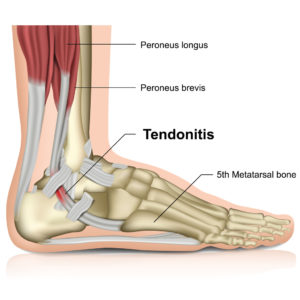By Tash Barry – Physiotherapist
Peroneal tendons can become irritated by inflammation or degeneration, resulting in lower lateral ankle pain. Pain and injury in the tendon/s can arise as a result of:
- A partial tear
- Complete rupture
- Subluxation
- Tenosynovitis
- A fractured os peroneum, or,
- Damage to the retinaculum that holds them close to your ankle
Anatomy:
There are two peroneal tendons, brevis and longus, which originate from muscles in the side of the lower leg (see image below). These tendons run behind the outer ankle bone (lateral malleolus), with the longer of the two inserting into the bottom of your big toe, and the other inserting onto the side of your little toe. They are responsible for pointing your foot (plantarflexion) and moving it out to the side (eversion). They also play an important role in stabilising your foot during weight-bearing activities such as standing, walking, or running.

Prevalence:
Peroneal tendon issues are common in runners, young dancers, skiers, ice skaters and athletes whose sport requires a frequent change of direction such as netball and basketball. They are also common in patients with chronic lateral ankle instability, or where the foot rolls out/there is a high medial arch.
What causes it: ❓
Tight calf muscles, inappropriate training or returning to activity following a period of extended rest, poor foot biomechanics, inappropriate footwear and muscle weakness can individually or collectively contribute to developing peroneal tendonitis.
Other causes include recurrent ankle sprains, repetitive or prolonged activity, direct trauma, or associated fractures of the foot/ankle.
Symptoms:
Patients with peroneal tendon issues present with:
- Pain over the lateral ankle or outside lower leg
- Swelling behind the ankle
- Pain during a heel raise/when lifting up onto your toes
- Pain with running, particularly when changing direction
- Pain with walking on uneven surfaces, such as sand
- Pain is worse typically first thing in the morning, or on standing after a period of not weight bearing
Diagnosis:
An assessment with your physiotherapist can help to confirm diagnosis. As well as gathering a detailed subjective assessment, objective assessment includes range of motion tests of the foot and ankle, resisted muscle and strength tests, a functional assessment, palpation over the tendons and locally, and general observation for any swelling etc.
A thorough assessment is sufficient to diagnose peroneal tendonitis. If required, your physiotherapist may refer you for an X-Ray pf MRI to rule out a fracture or more sinister cause of your pain.
Treatment: ✅
An individualised program will be prescribed depending on the type of tendon injury, and the stage of healing you are at. In the acute phase treatment can include:
- Ice
- Offloading with tape or brace
- Resting from aggravating activities
- Footwear modification or orthoses
- You may require a period of complete offload
Treatment then progresses into:
- Strengthening exercises
- Mobilisation or manipulation of the foot/ankle
- Massage or dry needling
- Proprioceptive and balance exercises
- Education on training intensity/frequency/duration
- Activity modification/technique
- Addressing other lifestyle factors that may be contributing including poor sleep, inactivity, or other injuries
Get in touch with one of our experienced physiotherapists today to book your assessment and start your rehabilitation journey if you are experiencing any aches or pains.
References:
https://radiopaedia.org/cases/peroneal-tenosynovitis-1
https://www.physio-pedia.com/Peroneal_Tendinopathy
https://www.footcaremd.org/conditions-treatments/ankle/peroneal-tendinosis


